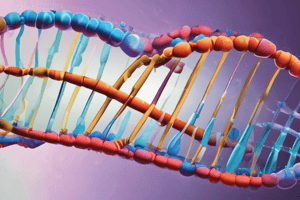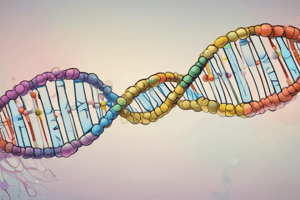Podcast
Questions and Answers
What is the primary purpose of DNA replication in a cell?
What is the primary purpose of DNA replication in a cell?
- To ensure two genetically identical daughter cells are produced (correct)
- To create genetic variation in daughter cells
- To repair damaged DNA
- To facilitate protein synthesis
Which enzyme is primarily responsible for synthesizing new DNA strands during replication?
Which enzyme is primarily responsible for synthesizing new DNA strands during replication?
- DNA helicase
- RNA primase
- DNA ligase
- DNA polymerase (correct)
In which direction does DNA polymerization occur during DNA replication?
In which direction does DNA polymerization occur during DNA replication?
- 3' to 5' direction
- 5' to 3' direction (correct)
- Randomly along the DNA strand
- In both directions simultaneously
What mechanism does DNA use to correct errors during replication?
What mechanism does DNA use to correct errors during replication?
What is the consequence of DNA mutations in an organism?
What is the consequence of DNA mutations in an organism?
What type of hydrogen bonds does adenine form with thymine in DNA base-pairing?
What type of hydrogen bonds does adenine form with thymine in DNA base-pairing?
What is the orientation of the two strands in a single DNA molecule?
What is the orientation of the two strands in a single DNA molecule?
Which combination of nucleotides includes the required building blocks for DNA replication?
Which combination of nucleotides includes the required building blocks for DNA replication?
How many hydrogen bonds form between guanine and cytosine in DNA base-pairing?
How many hydrogen bonds form between guanine and cytosine in DNA base-pairing?
Which model of DNA replication suggests that both strands of the parental DNA remain intact?
Which model of DNA replication suggests that both strands of the parental DNA remain intact?
Flashcards
DNA Replication
DNA Replication
The process where a cell creates two identical DNA molecules from one original DNA molecule.
DNA Templating
DNA Templating
One DNA strand serves as a pattern to create a matching complementary strand, using base pairing (A with T, G with C).
Base-Pairing
Base-Pairing
The specific way nitrogenous bases (A, T, C, G) in DNA bind together.
DNA Polymerization
DNA Polymerization
Signup and view all the flashcards
Replication Template
Replication Template
Signup and view all the flashcards
Base Pairing in DNA
Base Pairing in DNA
Signup and view all the flashcards
Hydrogen Bonds in DNA
Hydrogen Bonds in DNA
Signup and view all the flashcards
Anti-parallel Strands
Anti-parallel Strands
Signup and view all the flashcards
DNA Replication Requirements
DNA Replication Requirements
Signup and view all the flashcards
DNA Replication Models
DNA Replication Models
Signup and view all the flashcards
Study Notes
DNA Replication Overview
- DNA replication is the process of making a copy of a DNA molecule
- This process is essential for cell division and maintaining genetic information
- The process occurs in a semi-conservative manner, meaning each new DNA molecule consists of one original strand and one new strand
DNA Replication Requirements
- Template: The original DNA molecule serves as a template
- Enzymes: Various enzymes are needed for the process, including DNA polymerase, helicase, primase, and ligase
- Nucleotides: Free nucleotides (dATP, dGTP, dCTP, and dTTP) are needed as building blocks for the new strand
- A starting point: An origin of replication is necessary to initiate the process
Stages of DNA Replication (Prokaryotes)
- Initiation: The DNA molecule unwinds, forming replication forks, where the new strands of DNA will be built.
- Elongation: DNA polymerase adds nucleotides to the 3' end of the existing strand, following the template strand
- Leading strand: Synthesized continuously in the 5' to 3' direction
- Lagging strand: Synthesized discontinuously in short fragments (Okazaki fragments), also in a 5' to 3' direction
- DNA polymerase synthesizes both strands
- Primer required: A short RNA primer is needed for elongation to start
- Primase - makes the primer
- DNA polymerase III starts at the primer
- Termination: Replication ends when the two replication forks meet and the replication process is complete, creating two identical DNA molecules. The two molecules are separated and the process is complete.
- Multiple enzymes and proteins: Enormous amounts of enzymes and proteins are needed for each strand
Prokaryotic versus Eukaryotic Replication
- Similarities: Both use a semi-conservative process of DNA replication requiring a template, building blocks, enzymes, and a starting point
- Differences: Eukaryotes have many origins of replication, while prokaryotes have only one origin. Eukaryotic replication takes longer than prokaryotic replication
DNA Replication - Prokaryotic Details
- Single circular chromosome vs Multiple linear chromosomes
- Replicons and Origins
- Bidirectional synthesis: Replication proceeds in both directions from the origin. Creates two replication forks moving outwards
- Enzymes:
- Helicase: Unwinds the DNA double helix
- Primase: Synthesizes RNA primers
- DNA Polymerase III: Adds nucleotides to the growing DNA strand
- DNA Polymerase I: Removes RNA primers and replaces them with DNA
- DNA Ligase: Joins the Okazaki fragments of the lagging strand
Initiation
- Specific DNA sequence: Origin of replication (OriC) - starting point in prokaryotes
- DnaA binds OriC to start unwinding the DNA strands
- Helicase unwinds the DNA molecule into two strands. This creates a replication fork
- Single strand binding proteins (SSBs) prevent DNA from re-annealing
- Topoisomerase reduces the strain placed on DNA ahead of the replication fork during unwinding of the DNA
- Primase creates short complementary RNA sequences to the DNA strands (Primers)
- Primase begins DNA replication process for leading strand
- This occurs because DNA polymerase require a 3' OH group to add new nucleotides
Elongation Details: Leading Strand and Lagging Strand
- Leading strand: DNA polymerase can add nucleotides continuously to the 3' end of the leading strand
- Lagging strand: Synthesized in small fragments (Okazaki fragments)
- DNA polymerase requires a primer that is complementary to the DNA strand being copied
- Fragments are joined together by the enzyme DNA ligase
Elongation
- DNA polymerase III adds nucleotides to the 3' end of the growing DNA strand in a 5' to 3' direction, the new strand follows the existing strand
- Nucleotides: The template strand determines which nucleotides are added to the growing strand by base pairing rules
- A with T; C with G
- Directionality: DNA polymerase adds nucleotides only to the 3' end of the growing strand, therefore new DNA strands are synthesized 5' to 3'
- Leading strand elongation: Continuous
- Lagging strand elongation: Discontinuous – new fragments (Okazaki fragments)
- Importance of proofreading: Involves 3'-to-5' exonuclease activity of DNA polymerase – crucial for accuracy
Okazaki Fragments
- short, newly synthesized DNA fragments that are formed on the lagging template strand during DNA replication
- Fragments are joined together by DNA ligase to create a continuous lagging strand
Termination
- Replication ends when the two replication forks meet and the DNA molecule is replicated into two single stranded molecules
DNA Polymerases
- There are many polymerases and they have various functions, but the most important for DNA replication is DNA polymerase III
- Proofreading: 3' to 5' exonuclease activity - checks for errors before adding new nucleotides.
- Other processes in DNA replication:
- Mismatch repair to correct errors
- Environmental damage repair mechanisms
- Mutations: DNA replication errors can lead to mutations, alterations of the DNA sequence, that is sometimes essential to evolution
Eukaryotic Replication
- More complex than prokaryotic replication
- Multiple origins of replication (versus one in prokaryotes)
- Initiation sites
- Many origins allow for faster replication of larger genomes
- Nucleosomes need to be dealt with
Telomeres
- Specialized structures at the ends of eukaryotic chromosomes
- Protect from degradation
- Repeat sequences
- Telomerase (an enzyme): uses an RNA template to synthesize telomere sequences, maintains the integrity of telomeres
Error Correction - Proofreading
- DNA polymerases have proofreading mechanisms (3'-5') to correct errors during DNA replication
- Mismatch repair: Corrects errors missed during replication
- Enzymes scan the newly replicated DNA for mismatches
- Enzymes cut out the mismatched DNA section
- DNA polymerase fills in the gap, DNA ligase seals
Mutations
- Permanent changes in the DNA sequence
- Can result from errors in replication or environmental damage
- Mutation rates are typically low, but important for evolution
Studying That Suits You
Use AI to generate personalized quizzes and flashcards to suit your learning preferences.
Related Documents
Description
Explore the fascinating process of DNA replication, which is crucial for cell division and genetic integrity. This quiz covers the requirements, stages, and enzymes involved in both prokaryotic replication. Test your knowledge on how DNA is copied during cell division!




